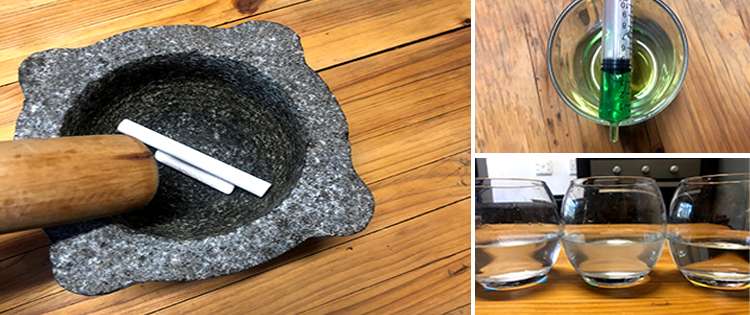Environmental pollution is one of the undeniable consequences of the industrial age. And all pollution, whether soil or air pollution, ends up in our water. This article will deal with some aspects of how you can assess your homestead’s water quality. There are many commercial testing kits and laboratories that offer analysis. The intention of this article is to make you more aware of indicators of water quality and pollution, that can help you determine whether you need to be worried.
Whenever scientists take the time to test water sources, they inevitably find traces of modern pollutants. While worrying, most pollutants and contaminants are present in levels low enough for humans to tolerate. But, what happens when pollutants rise above critical levels? And even more importantly, how would you know if there is pollution in your area and when your water is safe to drink or not?
The Invisible Needle in the Haystack
Part of the issue is that perfectly clear water could contain deadly levels of poisons, carcinogens, and even radiation. All these are completely invisible to the naked eye. But, if you learn to keep an eye on nature, and how your homestead’s environment reacts to your water, you should be able to detect some of the issues upfront.
The dangerous reality however is that in most instances, only expensive laboratory tests can detect and confirm the presence of every possible contaminant. This article should be viewed as a primer, to help you ascertain whether further testing should be done, and help you decide if water should be trusted. If you have serious and well-founded doubts, you should stop drinking your water until you can have it laboratory tested.
So let’s, without further ado, jump right in. Pun intended.
Living water
If humans could only survive on sterile and filtered water, our species would have died out long ago. We are made to drink living water. And by living water, I mean water that contains a multitude of living organisms, including bacteria and other micro-organisms.
Water that can sustain life, is generally safe to drink. If you feel unsure about the leaves and pond slime, you can give it a boil, and then it should be safe to drink.
Water that cannot sustain life should be avoided at all costs. If bacteria and micro-organisms, slime, fish, plants or amphibians cannot live in it, you should not drink it. Even after boiling. Have it tested or make alternative arrangements.
Sequence Of Use
If you are doubtful of the quality of your water, then avoid being the first organism to consume it. You can do this by having two or more reservoirs or tanks in which water is pumped before use.
Ideally, you would have ecosystems in the water. I would recommend fish and in particular frogs. If the ecosystem gets disrupted or shows signs of stress, you need to delve deeper.
You could also expose small birds, fish, and frogs to the water to see how they react. Domestic pets have high tolerances, especially for bacterially contaminated water, so don’t bother testing your water on them.
Water pH
Incorrect pH will cause malabsorption of nutrients in water plants and will lead to discoloration of foliage. Keep a keen eye on the water plants and the health of foliage, if they show signs of stress, it may be time to investigate.
Herbicides and Pesticides and Fungicides
Herbicides and Pesticides are amongst the greatest culprits when it comes to dangerous levels of contamination in water sources. The reason for this is that very small amounts can cause quite a lot of health and environmental damage in the long run.
If the levels are so high that you can smell or taste them, avoid the water. Also, many agricultural chemicals will cause an oily residue on the surface of water that when viewed at an angle, will reflect light in rainbow colors. But how will you know if there are low levels of contamination?
Frogs are a good indicator species in this regard. Some studies suggest that there may be between a 40% – 100% mortality rate for frogs exposed to pesticides. Herbicides can cause male frogs to become sterile of hermaphroditic. Some fungicides cause frogs to die, even if present in what is considered safe levels.
Similarly, pesticides kill most species of algae and water plants. Fish are another species that are adversely affected and may show mutations in the long term or immediate die-offs.
Any changes to the aquatic life in water sources should be viewed as serious.
Hard vs. Soft Water
The images below show the setup of the experiment. I started by grinding common board chalk, or calcium carbonate, down to a very fine consistency. Then prepare two equal amounts of water, one standard tap water, the other is a mixture of tap water and chalk. Then I added 1ml of dishwashing detergent to both batches of water in the shaker. The normal tap water will fill the shaker with suds almost immediately.
The water with the calcium carbonate never makes a good amount of suds, even after adding more and more detergent. Calcium-based minerals will increase the hardness of your water. The amount of detergent needed to make suds is an indication of this, while you will notice when washing hands in hard water, that you don’t get a good lather, and that the soap doesn’t want to rinse properly from your hands.
Grinding Up the Chalk
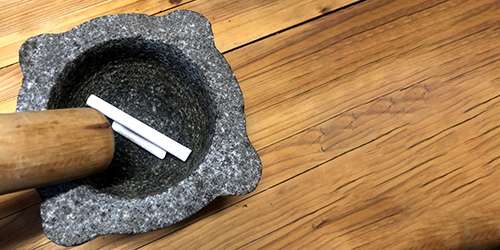
The Experiment Setup
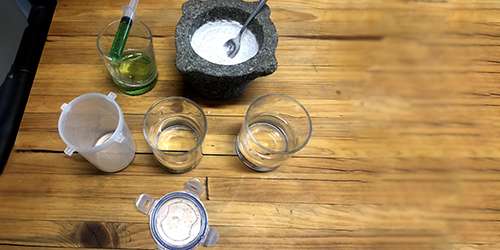
Washing Detergent
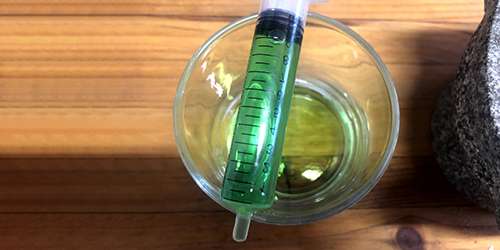
Adding 1ml At A Time
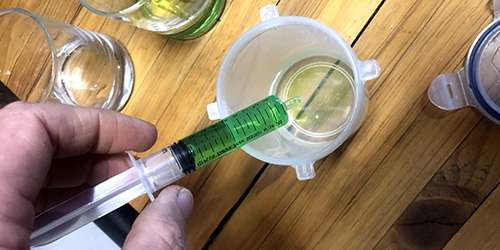
I put 1ml detergent in tap water and 1ml detergent in hard water.
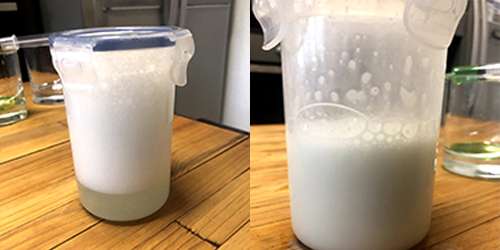
Mineral Rich Water
The below images show three samples of water. I have added copious amounts of sodium chloride to one solution, and magnesium sulfate to the other. The third is clean tap water. I then place them in the freezer overnight.
The Sodium Chloride (Table Salt) water never freezes completely and all you have is a slush of ice particles and fluid. The magnesium sulfate (Epsom Salts) freezes to a powdery consistency and the water freezes to ice as we know it. When removed from the freezer and left to thaw, the saltwater thaws first, then the normal water, and lastly the magnesium sulfate.
Minerals in the water change the fluid’s thermodynamics and this accounts for the differences.
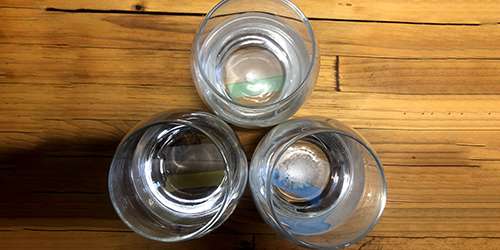
Experiment Setup: Green is Epsom Salt Water, Blue is Salt Water, Yellow is Tap Water.
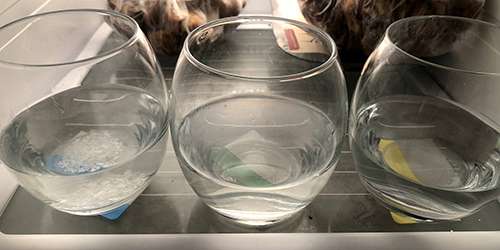
Place in Freezer Overnight
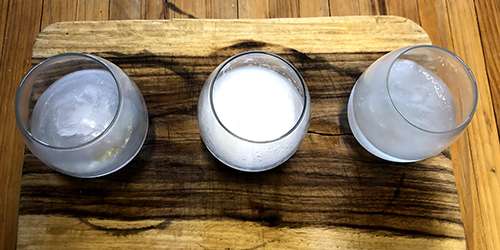
Mineral and Chemical Pollution
In many instances, high levels of certain minerals will discolor your water. Iron can make your water reddish, while other minerals may cause water to become milky or assume lightly colored hues. These effects can be witnessed by both the eyes and the nose. Visual and Olfactory senses should be trusted and viewed as an early warning system.
Water that has been exposed to mineral contamination will react differently to common household chemicals than what you would have become accustomed to. For instance, if you are rinsing shampoo from your hair in a shower, and the way the suds dissolve changes, contamination may be the cause. Learn how your water reacts to detergents and soaps and flag any unusual results.
Salts will increase the boiling point as well decreasing the freezing point of water. If you have a benchmark for your area’s water, you can use this to detect deviation.
Certain chemicals will cause water to produce foam, suds, or scum. This could also be of biological origin, but either way, the presence of suds is reason enough for you to investigate the origin.
Hard and Soft Water has different properties for soap solubility. Test the hardness of your water by mixing a drop of detergent in a vial of water and shaking the vial between adding drops. The idea is to agitate the detergent to cause suds. The more drops of detergent this requires, the harder your water is. If your homesteads water suddenly changes hardness, it could indicate pollution.
You may also like:
Is It Legal To Harvest Rainwater In Your State?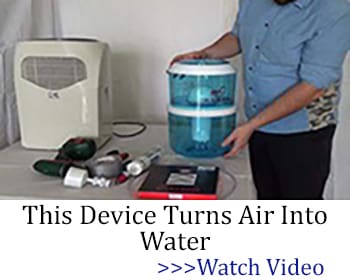
This Homemade Device Can Power Up Your Entire House 7 Days in a Row (Video)
How to Adjust the pH in Soil and Water for Abundant Harvests
If You Have This Plant in Your Backyard, You Will Never Run Out of Soap
